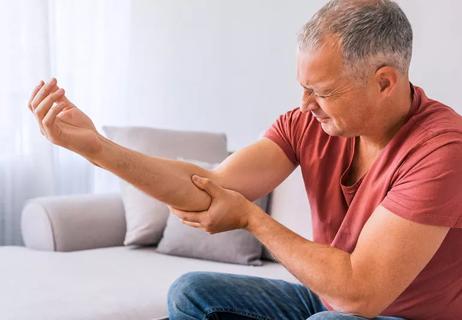Plus, exercises and movements to avoid

You don’t have to play golf to experience the pain and tenderness of medial epicondylitis, aka golfer’s elbow. “We also see it in people who play sports where they throw or weight lift and have jobs where they grip and hold things,” says physical therapist Matt Popiolkowski, PT, DPT.
Advertisement
Cleveland Clinic is a non-profit academic medical center. Advertising on our site helps support our mission. We do not endorse non-Cleveland Clinic products or services. Policy
If you have a mild case, rest may help relieve your symptoms, especially if you don’t have to continue doing the activity that caused the condition. But enlisting help from an orthopaedist or physical therapist can reduce recovery time and discomfort, says Dr. Popiolkowski.
“A physical therapist is a great first stop. Most of the time, you don’t need a referral. We can also refer you to the right doctor if needed as we start physical therapy exercises for golfer’s elbow,” he notes.
On the inside crook of your elbow, several muscles come together and connect. These muscles are responsible for flexing your wrist and fingers. Golfer’s elbow happens when these muscles are inflamed.
“Those muscles are always in use, and that’s their anchor point. When flexing and contracting, they tug and pull at that anchor point to do their job. The issue comes when those muscles are worked beyond their limit,” explains Dr. Popiolkowski. “The tissue fibers become disorganized and cannot function normally. This can cause pain, weakness and inflammation.”
Most people with golfer’s elbow experience elbow tenderness, even from a light touch. You might also have pain when you bend your wrist.
Dr. Popiolkowski says an effective golfer’s elbow treatment plan first starts with exercises to get your symptoms under control. Then, you do exercises to improve upper body mobility. Here, he shares seven golfer’s elbow stretches and exercises to help you heal and restore function.
Advertisement
Golfer’s elbow stretches and exercises can quickly improve symptom intensity and frequency, says Dr. Popiolkowski. “You may notice improvement during your first week of treatment. But it depends on how inflamed and irritated the tissue is. If the tissue is really affected, it could take six to eight weeks — or even longer — to see significant improvement.”
Three golfer’s elbow stretches and exercises he recommends for symptom control include:
This golfer’s elbow exercise involves minimal stretching and moving around the tissues to get blood flowing in the area. “Many people want to stretch the area because it feels tight, but pump the brakes on doing too much of that. The tissue is inflamed, irritated and not moving well. Stretching could make it worse,” says Dr. Popiolkowski.
Try this soft tissue rolling technique instead.
You can do soft tissue rolling a few times a day. Use less or more pressure, depending on how sensitive the area is.
Isometric exercises activate muscles against a fixed object so they can go through their range of motion without moving your affected joint.
“We want to rest the area while remodeling the tissue. Isometric exercises help control how these muscles contract,” says Dr. Popiolkowski.
Here’s how to do an isometric exercise for wrist flexion.
“These longer duration isometric exercises have been shown to help decrease pain levels,” says Dr. Popiolkowski. “Do this exercise daily and go for five to eight repetitions throughout the day. The longer you hold it, the fewer reps you have to do.”
“If you want, apply a little pressure at the end, but don’t hold it for a long static stretch,” adds Dr. Popiolkowski. “It’s just a little push up and down to maintain full mobility there.”
Advertisement
While reducing your symptoms, Dr. Popiolkowski says your physical therapist will also make sure your shoulders and back are moving well. “Good mobility in your back and shoulders can reduce the load on the muscles around your elbow and forearm,” he notes.
Try these four golfer’s elbow stretches and exercises for mobility.
“This exercise offers great rotation in your thoracic spine while you’re in a comfortable, stable position on the floor,” says Dr. Popiolkowski. “Do 20 to 30 repetitions of this movement daily.”
You can do this exercise while lying on your back or sitting in a chair with a low back.
Advertisement
“This exercise allows you to stretch your whole front side so you can extend your thoracic spine,” explains Dr. Popiolkowski. “Do this stretch 20 to 30 times a day.”
You should feel a stretch through the latissimus dorsi, the muscle underneath your armpit.
“Tighten your stomach during the motion, so you don’t cause excess movement in your back,” advises Dr. Popiolkowski. “This exercise does a great job of activating the muscles that help upwardly rotate the shoulder blade, creating better movement for your shoulders.”
While rehabbing, try not to aggravate your injury with movements that involve engaging the muscles in your forearm.
Advertisement
Golfer’s elbow exercises to avoid include:
Once you recover, prevent re-injury by maintaining:
Learn more about our editorial process.
Advertisement

What to know before seeking medical attention

Learn how this simple piece of equipment can help relieve elbow pain

Remedies and new options for tennis elbow

After knee arthroplasty, swelling-related pain is common, but infection and blood clots are also risks

You can improve your athletic performance over time by breaking up your workout regimen into focused cycles

Start training with full-body workouts at least six to eight weeks before you hit the slopes

Hanging upside down for any length of time may decompress the tension in your spine

To avoid swimmer’s eye, wear goggles, use eye drops and flush out your eyes with fresh, clean water when irritated

Start having sex about 72 hours before ovulation, then at least every other day during your fertile window

Attachment theory suggests that your earliest relationships shape connections throughout your life

It isn’t a recognized mental health disorder, but research shows that problematic social media use can negatively affect your mental health, self-esteem and sleep